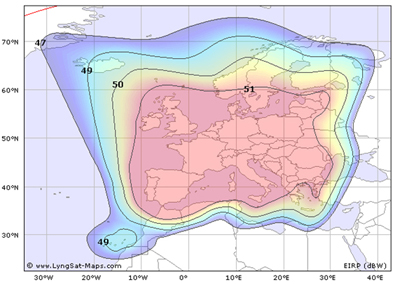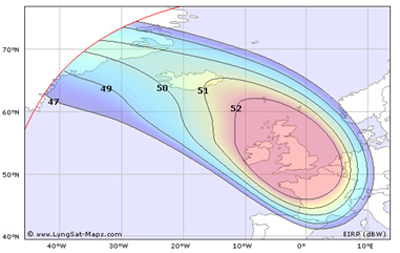¿Qué aspectos debemos tener en cuenta para una buena recepción de la televisión vía satélite en el autobús? Hay tres factores que son fundamentales para una correcta recepción durante el viaje: el tamaño de la antena satelital instalada, la huella de cobertura del satélite y las condiciones de la ruta. En este post, analizaremos cada una de estas tres variables.
El tamaño de la antena de televisión vía satélite ¿Importa?
Si importa. El tamaño de la antena necesario para la recepción del satélite en ruta en el autobús o en el autocar va en función de la potencia de los haces que iluminan el suelo (Pire ), que se explica en dBW, y de la dirección de estos: a mayor diámetro de la antena, mejor recepción.
Por lo tanto es mejor instalar una antena mayor que la recomendada por los fabricantes, así, no tendremos problemas de recepción en caso de mal tiempo. Algunos radiodifusores recomiendan antenas pequeñas para la recepción de sus señales, y especialmente en el caso de los satélites más potentes que emiten canales digitales (50 cm de diámetro de antena para la recepción de un satélite con un Pire de 50 dBW), incluso en este caso, es mejor elegir antenas con algunos centímetros de más.
Es importante recordar que una recepción defectuosa causada por una antena demasiado pequeña no tiene solución.
Huellas de cobertura de los satélites
El segundo aspecto que hay que tener en cuenta para conseguir una buena recepción de la señal de satélite en ruta en el autobús o autocar son las zonas de cobertura del satélite elegido (footprints en inglés). Estos footprints permiten una perfecta identificación de las características técnicas de su difusión, es decir, los límites de los territorios por los haces y el degradado de potencia de estos últimos.
Para facilitar la identificación de la potencia de emisión de los satélites, algunos satélites pueden modificar la dirección de sus haces por lo que estos mapas son puramente indicativos. Por tanto es necesario elegir un satélite, analizar cuál es su huella de cobertura y comprobar que las especificaciones técnicas de la antena permiten la recepción de la señal con la intensidad que llega a la zona por la que viajemos.
Vamos a enumerar las huellas de cobertura 4 de los satélites más importantes de Europa y analizar que tipo de antena sería la que necesitaríamos:
ASTRA 1 at 19.2 E
Aquí vemos que será necesaria una antena con una capacidad de recepción de señal de 51 dBW
ASTRA 2 at 28.2 E
En este caso necesitaríamos una antena con una capacidad de recepción de señal de 52 dBW
HOTBIRD 13 B
En este caso necesitaríamos una antena con una capacidad de recepción de 51 dBW
HISPASAT 1C at 30.0 W
En este caso necesitaríamos una antena con capacidad para recibir una señal de 52 dBW.
Condiciones de la ruta del autobús o autocar
Es interesante en algunas ocasiones analizar la ruta seleccionada va a realizar el autobús o autocar para garantizar esta buena recepción de la señal de satélite, porque evidentemente además de las condiciones meteorológicas (en días nublados la intensidad de la señal disminuye), la orografía influye mucho en la recepción de la señal. Carreteras estrechas con mucho arbolado, ruta por el interior de valles y rutas de montaña presentan algunas dificultades para la recepción de la señal del satélite.
Considerando cada uno de estos tres aspectos podremos conseguir una buena recepción de la señal de satélite en ruta y nuestros pasajeros podrán disfrutar de la televisión en directo durante el trayecto.




